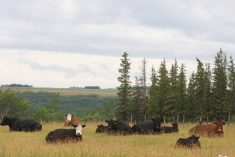Since the start of the Second World War, food guides in the western world have all shared a similar singular focus.
Military recruiters of the time were shocked to learn that many men at the time wouldn’t make adequate soldiers because their basic nutritional needs had not been met in the depths of the Great Depression. In Canada, of the first 50,000 men who signed up for service, more than four in 10 were rejected as unfit due to malnutrition.
Faced with the existential threat of fascism, the great democracies of the day sprang into action, taking their first serious interest in the diets of citizens since the late 1700s and the infamous “let them eat cake” comment attributed to French Queen Marie Antoinette. (Historians now question whether she actually said it, but it nevertheless became a revolutionary rallying cry.)
Read Also

Canadian hemp stable, but stuck on growth
Canada’s hemp industry hopes hybrid varieties, better yields, clearer regulations and new markets can help the crop break past its ceiling and get Canadian farmers planting more hemp acres.
Trapped on a small island and fighting for its very life, the United Kingdom wasted no time on niceties like rules for eating. It moved directly to heavy-handed intervention in the form of strict food rationing.
Counterintuitively the average diet of British citizens suddenly dramatically improved, according to the publication Medical News Today, which noted in a 2004 article that a varied diet rich in vitamins paid public health dividends. Infant mortality declined and, excluding deaths from hostilities, life expectancy rose.
The governments of Canada and the U.S. followed similar paths, with some notable distinctions.
There was some rationing, but mainly of important commodities such as dairy products and meat that were necessary to the war effort. An essay on the website wartimecanada.ca, details a much deeper effort, rallying around the slogan “food will win the war.”
They note “… rationing was just one part of a much larger set of state interventions into Canada’s kitchens. These included a concerted propaganda campaign to promote certain ‘patriotic’ foods, the wartime launch of an unprecedented national nutrition campaign, and the introduction of literally thousands of individual controls on the price, production, and distribution of everyday foods.”
In the U.S. the experience was very similar, with propaganda leaflets urging citizens to “eat these foods every day.”
Every step of these campaigns was calculated to build a healthy population of soldiers in the field and workers in the factory churning out munitions.
Following the war, the vision shifted to fulfilling the promise of lasting peace and general prosperity. Wartime technology soon arrived in farmers’ fields in the form of fertilizer, pesticides and mechanization. It was the dawn of the Green Revolution and the oft-decried ‘cheap food’ policy.
Perhaps not coincidentally, it was also the start of the era of expanding waistlines, and public health crises like rising obesity levels and growing rates of diabetes and heart disease.
At the same time, many of the food guidelines are said to have become a self-fulfilling prophecy where foods continued to be recommended to citizens as much out of force of habit and to placate the food industry than due to any nutritional science. Critiques include a “one-size-fits-all” approach that recommends a single path to healthy eating, and perhaps most crucially, that they ignore the impacts on the sustainability of food production as a whole.
In 1942, the year the federal government first issued Canada’s Official Food Rules, there was a total global population of 2.3 billion. As of January 2019, the United Nations estimates a world population of 7.7 billion. Some estimates suggest that will eventually peak at nine billion, others say closer to 11 billion.
Regardless of where the numbers settle, somewhere close to four times the global population will need to be fed out of the same ecosystem.
As poverty levels fall and nations develop, more are adopting at least elements of the western diet, including more meat consumption, and it’s becoming increasingly clear, according to researchers, that feeding that many people using the old model simply won’t work.
The latest report was published in the U.K. medical journal The Lancet, where researchers wrote that “… current diets are pushing the Earth beyond its planetary boundaries, while causing ill health.”
At the same time many of the elements of the study seem to be informing at least some of the thinking surrounding the newest iteration of Canada’s Food Guide, and even the government of China is encouraging the consumption of plant-based protein.
It would seem the food production model could be poised for another fundamental shift and food producers will need to be aware and prepared.
What the billions eat may change, but they will all continue to eat, and agriculture will need to meet those demands.















